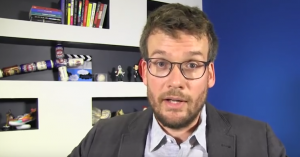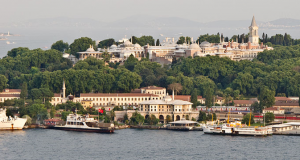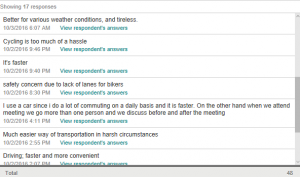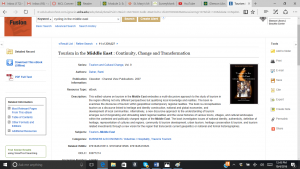As part of our homework, I chose to watch John Green, “Understanding the Refugee Crisis in Europe, Syria, and around the World” from group A and Isla Rowntree, “Teach your Kid How to Ride a Bike” from group B. Regarding the first video, it lasted for about 7-8 minutes and I was enjoying every single second of it. John Green really knows how to keep the audience focus and interested to hear more about what he has to say. He uses some of the linguistic components of Youtube voice mentioned by Julie Beck, in the her article “The Linguistics of Youtube Voice”. The way he stretched out the vowels, long vowels, when talking about the percentage of refugees who fled Syria and the difference between a “migrant” and a “refugee” was clearly evident. He also used the technique of aspiration and used his hands when he described the situation of the Syrian kid who died and was covered in blood on the beach in Turkey. I honestly think that these techniques made his video appear more intriguing to all the people watching it and I think that public speakers in general should consider using these techniques as it grabs the audience’s attention in a very indirect way. Whilst, regarding the other video from group B, I noticed how Isla also used most of the linguistic components of Youtube voice mentioned by Beck. She moved a lot and demonstrated some of the practices that kids should do in order to ride a bike by themselves. Acting the practices out in the open causes the person who is watching feel more engaged and so more interested to learn more about it. Isla also changed her tone of voice during the video and also stressed on some of the vowels to make her words come out in the way that she wanted them to. I personally believe that if public speakers in general were to follow such techniques, the chance of them becoming famous and successful is great.
Page 2 of 3
S3
At the end of my S2 presentation, I mentioned how I would love to instill the same biking rules that are in San Francisco back in Jordan but I did not get the chance to elaborate more on how I could do so and the reason behind my decision. I am currently majoring in Politics on the pre-law track and I am hoping of earning a law degree in the near future. So I thought of including my major in exploring my previous topic in all of its dimensions. For instance, in order to implement new transportation mediums and rules in Jordan, I have to know all about the Jordanian law before even thinking of moving forward with my aim. After knowing all about it, I would figure out ways and choose the right people who actually have the authority to implement changes in the cities such as the people in the council who were once elected to represent the citizens or those who work for the government. Working on implementing such decisions, would benefit the Jordanians significantly. Both from a health perspective and a physical one.
“Is It O.K. to Kill Cyclists?”
In his article “Is It O.K. to Kill Cyclists?”, Duane made me aware of something that I was not aware of at all. I never knew that cyclists are the ones to blame whenever an accident occurs. I used to think that drivers are always the ones to blame since they have all the power needed to actually harm the cyclists, and not vice versa. Also, in most accidents, as mentioned in the article drivers were not even cited nor charged for the death of certain cyclists and were set free to go. And somehow, to my surprise, the majority of people support the drivers and their excuses especially if they were not drunk because most people drive and so they sympathize with the drivers.
My fear of using a bicycle as a daily transport medium developed over time from the numerous horrible accidents that come out every day concerning the death of certain cyclists. I related to Duane because I also decided to overcome my fears of cycling during my stay in San Francisco. I want to become more of a sport person, lose weight and try to explore the world and the nature around me in a different view as most cyclists usually do.
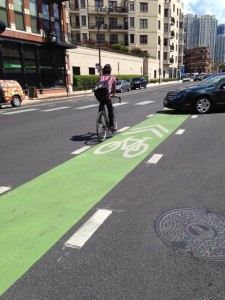
Reflecting on David Byrne
Byrne has a unique perspective on the world around him. He chose to use a bicycle as his transport medium in life and this allowed him to view the world around him in a different perspective, different than most people usually do. He is the type of person who appreciates nature and observes all his surroundings and tells people about it in a written form. I really liked the way he describes what he observes because it made me imagine it and put myself in his place and, In my opinion, this is one of the best ways that a writer could implement to grab the attention of the readers. He in a way observes stuff that cannot actually be seen and that was conveyed by the way he describes Cupertino; he describes it by saying “What little town there is lies nestled among the coastal hills were lining up to throw money at every geek with a vague idea, a pitch and some programming skills”.
Byrne also mentions the Topkapi palace in his piece, but does not really go deep into it. I chose to read more about it and explore it the same way Byrne did to most of the places in San Francisco. For a long time now, Topkapi Palace is considered to be one of the main residences of the members of the ottoman dynasty, called ottoman sultans. This gigantic beautiful palace is situated in Istanbul, Turkey and holds all special royal events for the state. Over time, however, things have changed and the palace is now a museum and a pretty well-known. It is very popular amongst the Islamic people in Turkey since the museum has some of the famous relics mentioned in the Quran which are Muhammad’s cloak and sword.
S2 Reflection
Two days before the presentation, I was stressing out. I had a math exam exactly the day after the presentation and I had to edit my essay for my rhetoric class as well. I had to manage my time carefully so that I would be able to finish all my homework and focus on all three assignments. I published the survey five days before the presentation was due, so collecting results was not really a main concern of mine. I also interviewed four people a day before the presentation which was a bit time consuming because I had to trim and edit the videos so that the four videos in total would not exceed a whole minute. Later, I had to write my whole speech which took around two hours because I had to discuss the results and analyze them rather than come up with new results or a conclusion on my own. I felt so ready to present my presentation to my fellow classmates and I wanted to perform it and tell everyone about how I explored the differences between the two cities.
On the day of the presentations, I felt confident while presenting because I knew that I researched enough and I put a lot of effort into it. Though I believe that there still is room for improvement which I hope to achieve next time. I also did not really like the way I stood and presented because I had to go to the laptop and play the videos which also took some time and I think I crossed my time limit. As for the content of my presentation, I chose to carry out two types of field research methods, a survey and an interview, which made my results appear more credible and reliable. I also presented evidence in the form of visuals, to attract the attention of the audience. So overall I think that I did pretty well this time especially that I had my speech memorized. I held two notecards with my hand consisting of four bullet points but I did not use them at all and felt so proud of myself.
Regarding other people’s presentations, I honestly think that everyone improved from previous presentations and did a pretty good job. Jack, for example, chose to interview people as his field research method and he showed us all the evidence in a clear way which helped us, the audience, connect with him. He wrote down all the answers that the interviewee answered on a PowerPoint and we were able to read it and follow up with him. I also realized how much effort Jack put into his investigation since he went to several bike shops, located in different parts of the city, just to interview them and collect evidence. He even showed the class one of the bike owners’ business card and this in a way engaged us, the audience, and grabbed our attention.
USF Speaking Center
I met with a girl called Claudia Sanchez at Malloy Hall. Our meeting did not last for long, only 15 minutes. We went over my speech and PowerPoint. We added around two sentences to conclude my presentation in a clear way. I personally did not really benefit from the appointment because I thought that I will practice it out loud and receive comments but that was not the case.
S2 Write-out
Hi everyone, my name is Dina Qubain, an eighteen-year-old student who’s majoring in politics. I come from the Hashemite Kingdom of Jordan, a country in the Middle East. When I first moved to San Francisco, I decided to explore the city and the American lifestyle because it’s all new to me. I noticed numerous differences, such as the type of food that people eat here, how people greet each other and how people spend their free time. In addition to that, when I finally started school, and attended the Public speaking class; speaking of bicycles, for some reason I started noticing all the people who cycle to get to work or school or wherever they’re headed. This was actually really interesting to me since none of the people in Jordan use bicycles. I wanted to see why they preferred driving over cycling.
First, I interviewed two of my friends from Jordan to ask them about cycling. Then I asked two of my new friends from school to make a comparison between the two cities.
(Display Videos)
I then carried out a survey to receive enough data and statistical information as to why people prefer driving. I created a survey containing five multiple choice questions and a one short answer question. I published this survey online and sent the link to my friends and family members back home and asked them to fill it out. 49 people got the chance to fill it out and the results are as follows (show all the questions).
As you can see, most people chose cycling over biking and some do not even own a bike. Those who do, do not even use them. Looking at people’s responses, I now know why what is:
a) There are no bike lanes in the streets where bikers could simply paddle and avoid all the cars. So there is simply no place for bikers to pass by and it’s too risky and dangerous. A lot of accidents might occur since you can find many crazy drivers on the streets.
b) No places to store your bikes at. People are not willing to buy themselves a bicycle and keep it with them all the time. Bicycles can easily be stolen so people are not prepared to buy expensive bicycles with the risk of it being stolen.
c) Since Jordan allowed almost 2.7 million refugees into the country, with very limited space the city is now overcrowded and there a lot of cars and traffic. Some prefer driving since cycling is too much of a hassle and it will require a person a lot of time to reach their destination.
d) Weather Conditions. The weather in Jordan can be too cold or too hot, there’s no in between. So some claim that they prefer driving because you can close the windows and open them whenever without even worrying about the weather outside. A much easier way of transportation in harsh circumstances.
e) Others prefer driving because they are too lazy to paddle all the way to get to their place of destination. They prefer a driving because it is simply tireless.
Carrying out the survey allowed me to reach a satisfying conclusion as to why the Jordanian people prefer driving over cycling. Even though I got a complex answer, I also realized that I could have done more with my research to make it better.
Strengths:
Gathering information from people of different ages from different parts of the world especially in the range 18 years old to 50 years old allowed me to receive a broader perspective and collect enough satisfying data.
Weakness:
Using at least one more type of field research would have allowed to me to gather more and more data. Hence, this would have made my results appear more reliable. Or if I had more time, I would’ve asked my American friends to fill out another survey, I would be able to make a clear comparison and come up with more results.
Biking here is a lot safer than biking in Jordan and I hope that one day I will be able to instill the same rules back home and allow the Jordanian people to enjoy bike rides.
Thank you
How Amos Winter ended his presentation:
Amon Winter ended his presentation by talking about the story of the Indian guy who had a spinal injury and wasn’t able to transport himself on the rough terrain from his house to the shop of where he worked at. After that a video of the Indian guy was displayed, thanking Winter for his invention that saved his life and encouraged him to proceed with his daily activities and continue working at the shop. He ended his presentation with a clincher; “And thank you very much for having me today.”
GL Fusion Search
The library itself seems to have numerous books and very beneficial resources because if you type at least a word in the search box, a minimum of 40 books will automatically appear. My S2 topic is focused more on cycling in the Middle East and Jordan in specific, which is a very weird topic that people don’t tend to work on so I did not really find anything related to my topic. However, I found this one book called Tourism in the Middle East : Continuity, Change and Transformation by Rami Daher, which talks about the culture and the traditions in the Middle East which in a way or another can be related to my topic.
Amon Winter (TED Talk)
Amos Winter, a chemical engineer, addresses during his ted talk the cheap all terrain wheelchair. He mentions how in the united states, people with disabilities do not feel as excluded or not accepted by the society around them as people in less developed countries do. People living in the US have as much available stuff as nondisabled people do; they can still wander around all the streets of the cities and can use public transportation whenever needed. There is one issue though, some disabled people do not have enough money to buy a normal wheelchair especially the developed types of wheelchairs that enable people to travel on rough terrains. These special types of wheelchairs usually cost about 4000 dollars or even 5000. That is why, most poor people who are disabled and cannot walk are actually left alone at their homes with no work or nothing to do and are excluded from the world. Amos Winter, came with a cheap all terrain wheelchair that costs no more than 200 dollars. This creation of his allowed people from all around the world even those who are poor, to access it and pursue with their normal lifestyles and daily activities. Not only did the cheap all terrain wheel chairs benefitted the people significantly, bas also had advantageous results on the surrounding community.
As for the evidence used in Winter’s presentation, he used visuals such as pictures and videos showing how people used the wheel chair and how happy and grateful they were because of this unique invention. He even showed a video of someone thanking him for creating such wheelchairs and how he saved his life by encouraging him to work.

